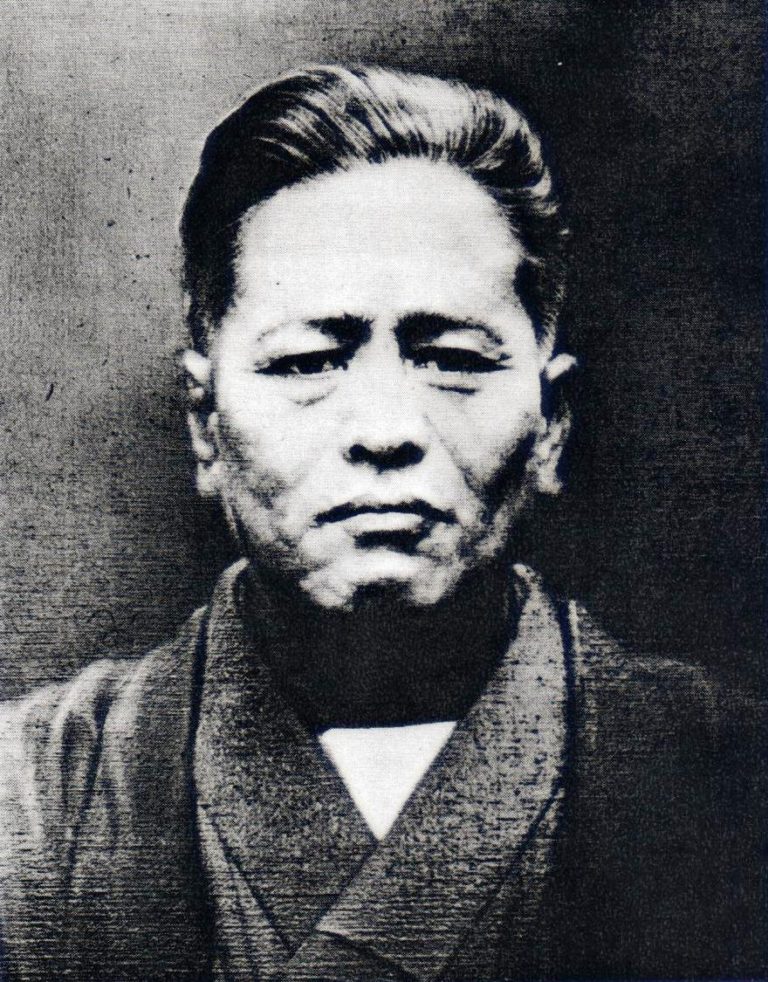
The History of Goju-Ryu Karate
A great deal of pride is taken in being able to trace the lineage of instructorship and mastery of a particular martial art back to the individual grandmaster credited with founding that particular style.
By clicking on each of the masters´ names below, you will gleam a small part of the history and succession of our martial art from its Okinawan and Chinese roots at the turn of 19th Century to the present day.
Kanryo Higaonna Shihan, 1853-1916 (Naha-te Founder)
Chojun Miyagi Shihan, 1888-1953 (Gojo-Ryu Founder)
An´ichi Miyagi Shihan, 1931-2009 (Master IOGKF)
Morio Higaonna Shihan, Born 1938 (Former IOGKF)
Tetsuji Nakamura Sensei, 1965-Present (IOGKF World Chief Instructor)
Kanryo Higaonna Shihan, 1853-1916, Naha-te Founder
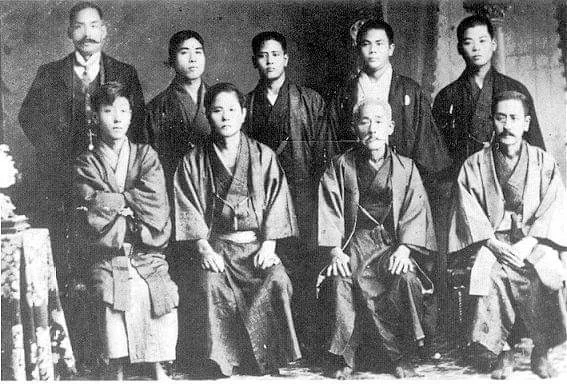
Goju-Ryu founder, Chojun Miyagi Bushi (back row, centre) and Kanryo Higaonna Bushi (front row, third from left) who was his main teacher. The photo is estimated to be circa 1910.
Source: IOGKF Historical Timeline – IOGKF International – External Link
Please note that owing to the different ways Japanese can be translated into English you may often see Kanryo Hiagaonna referred to as Higashionna Kanryo.
Kanryo Higaonna was born in Naha, Okinawa in 1853, he was one of eight children. His father made his living trading firewood between the local islands. Kanryo Sensei helped his father from the age of ten, and the hard work made him very strong. From childhood Kanryo Higaonna showed great interest in the fighting arts and was eager to learn as much as possible. By all accounts he was known for being very supple and quick on his feet, despite his small size.
At age fourteen Kanryo Higaonna began to learn Chinese Kempo. His well developed and strong body enabled him to master Chinese Kempo and he quickly built a reputation as a martial artist master in Naha. Unsatisfied with his level of skill, Kanryo Higaonna longed to go to China to study the Chinese martial arts and their culture. Unfortunately, his family´s financial circumstances was unable to offer him the freedom to travel.
As chance would have it, Higaonna Sensei´s instructor introduced him to Udon Yoshimura, a ship-owner in the port city of Naha. It was Udon Yoshimura who eventually sponsored Higaonna Sensei´s passage to China. At the age of sixteen, he left Naha for the Chinese port of Foochow where he stayed at the Okinawan settlement called the Ryukyu-kan. It took almost a year for Higaonna Sensei to be introduced to the local master of Chinese Kempo in Foochow, Master Ryu Ryuko.
Even after Higaonna Sensei was introduced, he was not immediately accepted as a disciple. The Chinese masters would take the time to study the personality and character of candidates before accepting any disciples. Thus, Higaonna Sensei was given tasks of tending the garden and cleaning the rooms of the master and did these tasks earnestly and enthusiastically over a long period of time. Impressed by his attitude, Master Ryu Ryuko finally accepted Higaonna Sensei as his personal disciple.
As a disciple, Higaonna Sensei would help his master at his trade as a bamboo craftsman by day and then train after dark. Training began with the practice of Sanchin, then lifting the Nigiri-game (heavy ceramic jars) by their rims to strengthen the student´s grip while practicing Unsoku-ho (a pattern of stepping movements) to develop proper footing. Exercises continued using the Muchi-ishi (natural stone) and Makiwara (striking post) as well as an Uki (bamboo basket) where two persons would practice close fighting and choking techniques inside. These new tools and training techniques fascinated Higaonna Sensei and increased his interest in karate even more. The harsh training took its toll, however, and his legs, hands and shoulders were always swollen from over exertion. Nevertheless, it was this harsh training that enabled him to develop his muscles like forged steel. After several years of harsh training, he became his master´s most skilful disciple.
Throughout the city of Foochow, the fame of Higaonna Sensei as a great martial artist gradually spread. An episode involving a discussion between students of two dojos (training place) lead to a competition in order to demonstrate who was superior in skill. In order to choose a superior martial artist without anyone getting hurt, each master chose their best student to perform kata instead of free style fighting. Higaonna Sensei was chosen to represent his dojo. The students from the other dojo were struck with admiration as they watched Higaonna Sensei perform the Sanchin kata. Afterwards, the master of the other dojo admitted Master Ryu Ryuko´s art was superior to his own and Higaonna Sensei´s fame spread even further. Many martial artists tried to engage him in a fight to prove their bravery but Higaonna Sensei kept his promise to his master not to fight to show off his skill and declined these challenges.
Higaonna Sensei stayed as a disciple in Foochow for about thirteen years, after which he returned to Okinawa. Higaonna Sensei visited the owner of the ship, Udon Yoshimura, who had made his passage to China possible. Udon Yoshimura asked Higaonna Sensei to teach his sons some of the skills he had learned in China.
Higaonna Sensei´s fame spread rapidly throughout Naha, attracting the attention of the King of the Ryukyu Dynasty. Thus for many years, he taught the martial arts to the members of the royal family as well. However, many people in the town came to Higaonna Sensei and asked to be taken on as personal disciples. But due to the harshness of the training, only a few remained with him for long. Amongst his disciples, a young Miyagi Chojun was one of the few that remained. Higaonna Sensei had opened his house in Nishimachi as a dojo and was teaching his art to his disciples without charging any tuition. In addition to his private instruction, Higaona Sensei began teaching at a public high school in Naha at the request of the principal in 1905. He introduced to the students both the physical and spiritual value of his martial art.
During his thirteen years in China, Higoanna Sensei mastered many traditional martial arts, such as, the art of the straight sword. His technique in these various martial arts was truly art in motion. His hands and legs possessed extraordinary spring making his movements fast as lightening. People were surprised that one so small, five foot one inch, could have so much power and strength and referred to him as Kensei, meaning “sacred fists”. Gradually, the art of Higaonna Sensei became known as Naha-te, “Naha” referring to the region of Naha in Okinawa and “te” meaning hand technique. He devoted his life, along with his disciple Miyagi Chojun Sensei, to the improvement and advancement of the art of Naha-te. Early in 1916, Higaonna Sensei fell ill and passed away in October 1916. Thus, the art of Naha-te was handed over from Higaonna Kanryu Sensei to his disciple Miyagi Chojun Sensei.
Higaonna Kanryo Sensei is honoured today as the founder of Naha-te karate.
Chojun Miyagi Shihan, 1888 – 1953, Goju-Ryu Founder

Chojun Miyagi Shihan
Chojun Miyagi was born on 25th April 1888 in Okinawa. At the age of five he became the heir to the Miyagi family. His training in karate began at the age of eleven under Ryuko Aragaki Sensei who practiced and taught Tomari-Te. When he was fourteen his teacher introduced him to Higaonna Kanryo Sensei. Chojun Sensei trained with Kanryo Sensei from 1902 until October 1916, when Kanryo Sensei passed away.
During this time he was one of the few people who could withstand the severe training given by Kanryo Sensei. After the death of his teacher, Chojun Sensei continued with his own development including trips to China and research into physiology.
Chojun Sensei was instrumental in registering Karate at the Butokukai in Japan. He developed the Junbi-undo we practice today, and introduced the basic kata Gekisai Dai Ichi and Dai Ni. He also developed Tensho and a revised version of Sanchin.
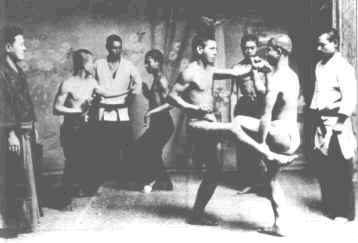
Students practice bunkai from Saifa kata as Chojun Sensei watches
In addition to his personal training and development of Naha-te, Chojun Sensei spent a great deal of his time promoting the art. In 1921, he performed a demonstration of Naha-te in Okinawa for the visiting Prince Hirohito, Emperor of Japan, and in 1925 for Prince Chichibu. Chojun Sensei had already envisioned the development of Naha-te not only in Japan but also around the world. It became increasingly important to organize and unify Okinawan karate as a cultural treasure to be passed on to future generations. In 1926, Chojun Sensei established the Karate Research Club in Wakas-Cho. Four instructors, Chojun Sensei, Hanashiro, Motobu and Mabuni, taught alternately some preliminary exercises and supplemental exercises. Afterwards, Chojun Sensei gave talks to the students about mankind, daily life, and the samurai code of ethics in order to improve their moral development as well. In 1927, Jigoro Kano Sensei, founder of Judo, saw a demonstration of a kata by Chojun Sensei and was impressed by the advanced technique and sophistication of Naha-te. Kano Sensei´s influence allowed Chojun Sensei to perform Okinawan karate at leading Japanese Budo tournaments sponsored by the government. In 1930, Chojun Sensei performed at the Butoku-kai Tournament and then later at the Sainei Budo Tournament in 1932.
As its exposure increased, many became interested in Chojun Sensei´s style of martial arts. One of his senior students, Jinan Shinzato Sensei, gave a performance of kata at a Japanese martial arts tournament. Afterwards, a master asked the name of his school. Shinzato Sensei had no answer for him, and upon his return to Okinawa he told Chojun Sensei about his encounter. In order to promote his art as well as cooperate with other schools of Japanese martial arts, Chojun Sensei decided it was necessary to name his martial art. It became known as Goju-Ryu Karate, meaning “hard and soft” taken from the precepts of traditional Chinese Kempo. He was the first among different schools of karate to name his art and in 1933 his art of Goju-Ryu was formally registered at the Butoku-kai, Japanese Martial Arts Association.
Chojun Sensei travelled extensively, spreading Goju-Ryu to mainland Japan and as far afield as Hawaii after a local Hawaiian newspaper company invited him to introduce and promote karate in Hawaii in 1934. Two years later Chojun Sensei spent two months in Shanghai, China, for further study of Chinese martial arts. In 1937, he was awarded a commendation by the Butoku-kai for his kata. Chojun Sensei continued to develop Goju-Ryu by analyzing and employing scientific methods of exercise in his research. His work found many practical applications and it is no surprise to learn that many of his students were in the police force.
At this point the Second World War interceded, and the aftermath led to a prolonged period of severe hardship in Okinawa. Not surprisingly, the few students who survived the conflict could no longer train. Of those that lost their lives during the war, was Chojun Sensei´s top student Shinzato Jin´an, who was to have succeeded him.
As normal life returned again to Okinawa in the aftermath of the war, Chojun Sensei began teaching again in his garden dojo. Realising that he had so much knowledge to pass on, Chojun Sensei began grooming a new and promising young student called Anichi Miyagi (no relation) to succeed him. They trained on a one to one basis similar to the method he was trained by Kanryo Sensei.
Sadly Chojun Sensei passed away on 8th October 1953. One hopes he appreciated that he had succeeded in sowing the seed that would not only preserve his life time´s work to Goju-Ryu karate, but see it expand into a global martial art.
An´ichi Miyagi Shihan, 1931 – 2009
An´ichi Miyagi was born in Okinawa on 9th February 1931. When he was fourteen both of his parents died. He was then left with the task of bringing up his two younger brothers. He began his karate training with Chojun Miyagi Sensei in 1948. Such was his devotion to karate and respect for his teacher that he was taken as Uchi Deshi (special student) by Chojun Sensei.
During this time An´ichi Sensei practiced all the kata of Goju-ryu along with the basic bunkai and many of the hidden bunkai were also taught to him, he diligently practiced Hojo-Undo, Junbi-Undo and Sanchin to increase his power.
This strict regime went on until the untimely death of Chojun Sensei on 8th October 1953. After a respectful period of mourning for Chojun Sensei, it was decided to continue with the dojo in Chojun Sensei´s garden. Many of Chojun Sensei´s seniors from before the war helped. Miyazato Eichi assumed the role of dojo head and Koshin Iha was in charge of administration but An´ichi Sensei did most of the teaching.
The garden dojo moved to new permanent premises and An´ichi Sensei continued to teach up to the time when he had to move away with his job on an American oil tanker.
An´ichi Sensei served the IOGKF as Honorary Chairman and was the personal adviser to the IOGKF for many years up to his passing away in 2009. We have been very fortunate to have benefitted from this direct link back to the founder of Goju–Ryu, Chojun Sensei. The mantle of the future development of Goju–Ryu now of course passes to Tetsuji Nakamura Sensei.
Morio Higaonna Sensei, 10th Dan
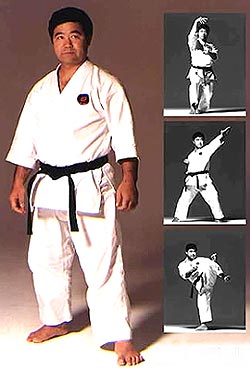
Morio Higaonna was born 25th December 1938, and he began his karate training when he was fourteen. He studied Shorin-Ryu with his father. He was also training with a friend, Tsunetaka Shimabukuro, another Shorin-Ryu stylist. At the age of sixteen he began to train in the Goju-Ryu style on the recommendation of Shimabukuro Sensei. The year was 1955 and the young Higaonna was training in the garden dojo of the late Chojun Miyagi Shihan, his instructor was An´ichi Miyagi Sensei.
At that time the training regime was very tough and Higaonna Sensei tells us of the countless times he would practice kata or kakie training with many different opponents until he could no longer move his arms. Anyone who has trained in Okinawa will know that due to the climate this requires tremendous effort.
In 1957 the garden dojo moved to a permanent building called the Jundokan. Hiagaonna Sensei continued his training there, five hours every day. After his instructor, Anichi Miyagi Sensei moved away to work on an American oil tanker Higaonna Sensei gained a place at the Takushoku University in Tokyo, it was around this time that the first official Dan grading was organised. Higaonna Sensei was awarded 3rd Dan. The year was 1960. It was in Tokyo that Higaonna Sensei taught at the famous Yoyogi Dojo. Many thousands of students passed through this dojo. Some of the more notable Senseis´ were Ogawa, Todano and Terauchi; from the West, Ernest Brenech, James Rousseau, Bakkies Laubscher; and from Shotokan Karate, Terry O´Neill.
During the late sixties and early seventies Higaonna Sensei began travelling to several of the countries that were practicing Okinawa Goju-Ryu. He was invited to perform a demonstration at the World karate Championships in Paris in 1972 and his reputation as one of the strongest Goju-Ryu practitioners in the world was growing. Higaonna Sensei received his 10th Dan certificate, awarded by An´ichi Miyagi Sensei on September 5th, 2007.
In 1979 in Poole, England with the help of his senior international instructors the IOGKF was formed. The primary objective of the IOGKF remains the preservation of traditional Goju-Ryu Karate as taught by its founders, and it is now a proud member of the Nihon Kobudo Kyokai (Japan Traditional Martial Arts Association).
Higaonna Sensei also received a special certificate signed by Aragaki Shuichi Sensei and Miyagi An´ichi Sensei (both direct students of the founder of Goju-Ryu, Chojun Miyagi Sensei) that recognises him as a student in the direct line descended from Miyagi Chojun Sensei.
Miyagi An´chi Sensei and Aragaki Shuichi Sensei both felt that recognizing Morio Higaonna Sensei as part of the Goju-Ryu lineage is important for the future of Goju-Ryu being passed on to future generations.
Anyone who has ever met Higaonna Sensei will not only be impressed by his karate ability, but also by his humility and good natured personality. It leaves you with the feeling of having met a true master of karate.
Higaonna Sensei appointed and trusted the future of the IOGKF to Tetsuji Nakamura Sensei in 2012 and resigned from the IOGKF in 2023.
Tetsuji Nakamura Sensei, 8th Dan, IOGKF World Chief Instructor
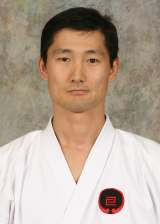
Sensei Nakamura is both the IOGKF World Chief Instructor and Canada Chief instructor.
In July 2012 he was appointed by Master Higaonna as IOGKF World Chief Instructor. Sensei Nakamura is assisted by Sensei Ernie Molyneux (9th Dan) and Sensei Henrik Larsen (8th Dan) as the Vice Chief Instructors.
Sensei Nakamura has been training in Goju Ryu Karate for over 30 years. He was a student in Okinawa, Japan, and received instruction from karate masters with direct descendant from the founder of Goju Ryu, Karate-Master Chojun Miyagi.
Sensei Nakamura has won three World Championships – twice in kumite (sparring) and once in kata (forms). He was an uchi deshi (special disciple) and head assistant instructor under Master Morio Higaonna (10th Dan) at the world headquarters in California, USA (1991-1994) as well as at the Japanese headquarters in Japan (1995- 1997). He moved to Canada in 1997 as technical advisor for IOGKF Canada.
Sensei Nakamura travels internationally to teach karate seminars. He holds a law degree and a teacher’s licence for philosophy, politics and economics from Kagawa University, Japan. He holds an IOGKF 8th dan and a 2nd dan in Judo.
Higaonna Sensei appointed and entrusted the future of the IOGKF to Tetsuji Nakamura Sensei IOGKF Chief Instructor in 2012.